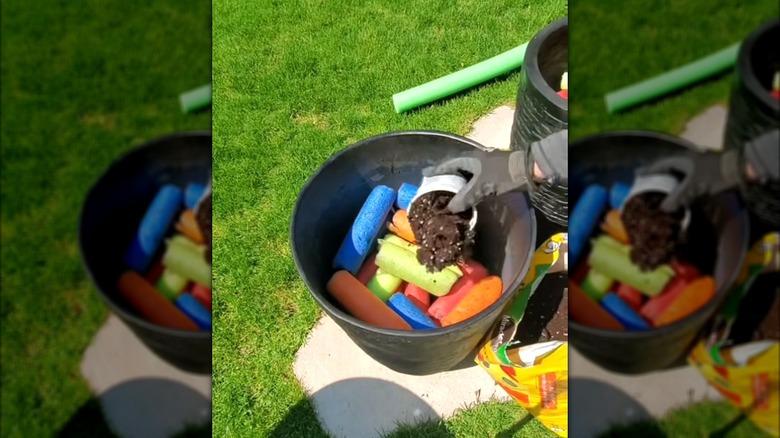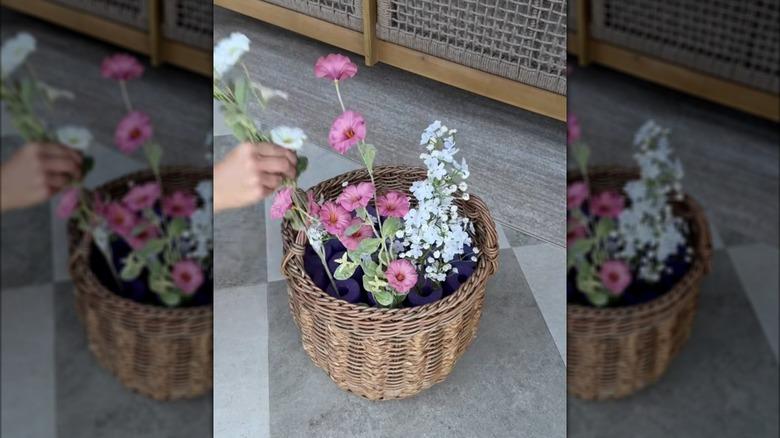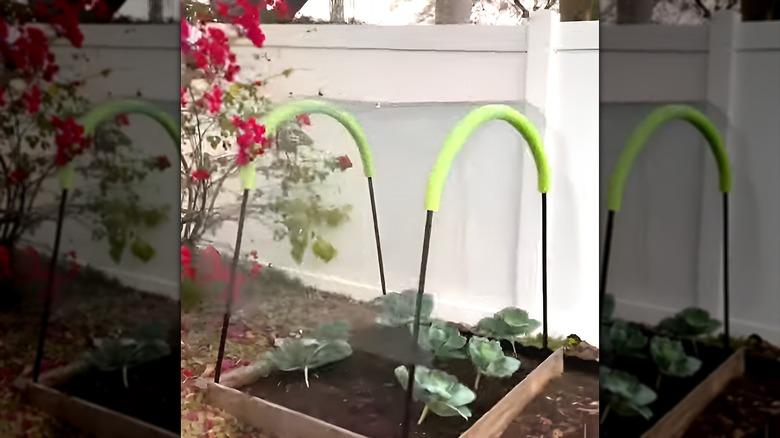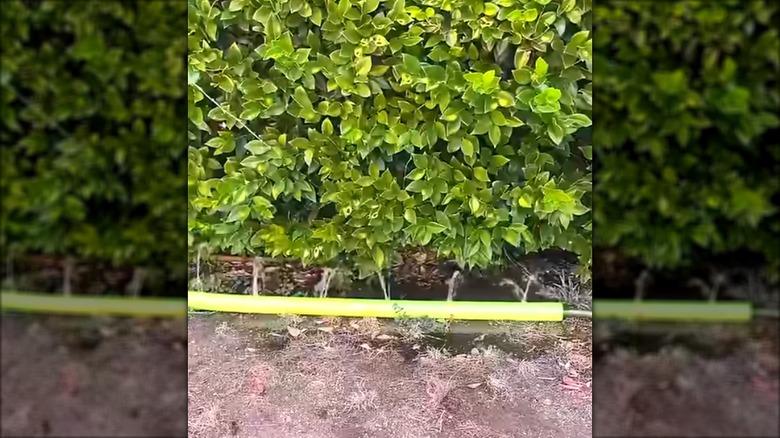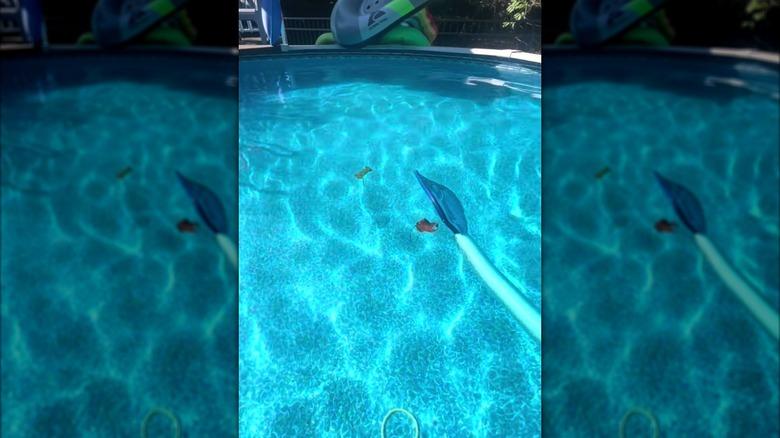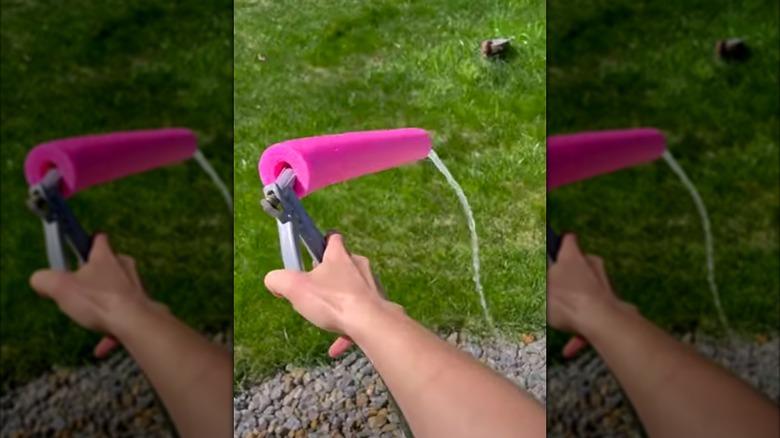11 Genius Pool Noodle Hacks That Are Game Changers For Your Garden And Yard
Since their invention in the '80s, pool noodles have become a staple for anyone who owns a swimming pool. Now, these colorful toys you loved as a child are just as useful as ever, though you may be surprised to learn everything you can do with them. Although they may seem like they're just strips of foam, these floaties can solve several yard and garden issues. Whether you want inexpensive DIY plant-growing hacks, added comfort to your gardening tasks, or want to make growing plants even easier, there's a pool noodle hack for you to try.
There are several attributes of pool noodles that have made them a go-to product for several yard and gardening upgrades. These neon tubes are made from a plasticky foam material, so they're incredibly lightweight, waterproof, and pretty cushy. They bend without breaking and are easy to manipulate, yet they're sturdy enough to hold their shape under pressure. Plus, you can't forget how inexpensive they are. As the weather warms up, pool noodles hit the shelves at nearly every store and can even be found at dollar stores for only a buck-twenty-five. If you have some old sun-dried noodles taking up storage space, don't toss them out just yet. Plastic can stick around for hundreds of years, clogging up landfills and oceans. Believe it or not, those old noodles have some life left in them, and they're perfectly fine for many of the garden upcycles below.
Soften sharp raised garden bed edges with pool noodles
There are several benefits to starting a raised garden bed, like having more control over the soil quality and dealing with fewer pesky weeds, but sharp or splintering edges can snag your trailing veggies — or your clothes while you're gardening. Luckily, pool noodles provide the perfect shape and cushiony material to smooth out any rough areas, giving your veggies a soft, rounded rim to grow over. With more protection, you won't have to worry about wounds becoming the perfect opening for disease-causing pathogens to enter (your plants or you if you get a scrape). Plus, the foam insulates against hot, sun-baked metal, keeping your vines cool and creating less of a risk of stress from direct heat (or even radiant heat).
TikToker @rooftop2table came up with the idea to use nothing more than a scored pool noodle to gently round out sharp garden bed edges. This trick also works well in other areas of your yard, like lining hard metal railings to create a cushion for energetic children. Try to avoid noodles made with polyvinyl chloride (PVC) or polystyrene, as they can leach harmful chemicals into the soil. Floaties made with ethylene vinyl acetate (EVA) are considered non-toxic, so they're your best option. Polyethylene foam is also generally safe, though it can still release small amounts of toxins in extreme heat. Most pool noodles tend to deteriorate with excessive sunlight, so check on them once a month or so and replace them if they start to feel dry or brittle.
Support small plants with pool noodles in a hydroponic garden
Do you want to grow an herb garden or have fresh leafy greens on demand, but you have limited space? Hydroponic gardening is a soil-free option that keeps bulky containers from filling up your windowsill, and you'll get faster and bigger harvests than with soil setups. Aside from a tub of water and your favorite seeds, you'll need something to hold the stems and leaves above the water. Pool noodles are buoyant, flexible, and don't crumble in water, making them the perfect material to gently cradle your tiny seedlings.
As long as it can hold liquid and is made with a food-grade material, nearly any container will work for your system. Similarly, any time you use pool noodles in conjunction with edible plants, it's equally as important to choose a non-toxic option. To start seeds in your hydroponic system, you can purchase seed-starters, like Tigvio's grow sponges, which allow them to sprout in water. When using spongy cones, cut the foam tube into small discs, stick the cone through the hole, and float the disc on the water's surface while the seed is submerged. If you start your plants in soil, TikToker @keep_on_growin demonstrates how you can cut a pool noodle in half lengthwise and add slits down the side before sliding your seedlings in. The pool noodle perfectly holds the stems in place, while the roots are free to grow underneath.
Use pool noodles as an inexpensive soil saver in large containers
When daydreaming about starting a container garden, the fantasy bubble may burst once you realize just how much soil you'll need to fill all of your pots. It's not just the price that adds up, but the physical weight of your planters also increases with every inch of dirt you add. Lining the bottom of your containers with cut-up pool noodles is a cost-effective solution that lightens the load and saves you money on high-quality soil. Used, non-toxic noodles function just as well as new ones, and the water-resistant foam works perfectly to guide excess moisture through the drainage holes.
A 2022 study performed by independent researcher Avery Rowe found that adding a drainage layer either had no effect on water retention in heavier, loam-based soils or actually reduced retention in lighter, soilless mixes. Simply put, even if your potting mix is on the heavier side, filling the bottom with foam won't trap extra water, and in lighter blends it'll help excess moisture drain away faster. A thicker layer of coarse material seemed to yield the best results, so cut your pool noodle into smaller chunks to create a more consistent texture and provide several air pockets to give water multiple points to flow through. Aim to line just the bottom third with foam so the roots have plenty of room for growth, enough space for drainage, and a good chunk of soil (and money) saved.
Add pool noodles to a basket to create a faux floral display
Whether you struggle to keep real plants alive, prefer a no-water centerpiece, or simply want year-round color, faux flowers always have your back. While there's nothing wrong with using floral foam to hold them in place, old pool noodles make a surprisingly good alternative. You can cut up a few tubes and stand them upright in baskets to use the holes as a guide to space your flowers evenly. If you want more control over the placement, then all you have to do is lay the floaties horizontally and stick the stems directly into the foam. They're flexible and easy to cut, so nearly any container will work. TikToker @ashleymariesavage_ shares how she created a beautiful floral arrangement using pool noodles for her home, but you can easily use this idea for your yard, deck, or patio.
You don't need to purchase new noodles for this hack, making it a great way to breathe new life into used ones that would otherwise be tossed out. If you're using a wicker basket with gaps, glue fake moss around the noodle edges or over the holes to conceal the bright colors. You can use the foamy material to hold other decorative items in place, too. Create eye-catching centerpieces for summer patio dinners by sticking in wire photo holders, festive flags, or holiday picks. Alternatively, you can skip the container altogether and use a pool noodle as a base for a colorful door wreath.
Make an outdoor squeegee with a pool noodle and a garden rake
Between kids splashing in the pool, heavy rainfall, and sprinkler systems, your sidewalks or patio can quickly become a slippery mess. Even worse, the standing water can encourage algae and mold growth or even become a breeding ground for mosquitoes. Rather than adding another gardening tool to your collection, you can cut off a piece of a cheap pool noodle and attach it to a rake to make a squeegee. The sturdy, water-repelling foam is the perfect material to push pooled water, and the noodle's flexibility allows it to more easily mold against the flooring, making sure no moisture is left behind.
TikToker @randyandco demonstrated this genius pool noodle hack, cutting the foam tube to size and creating a slit for the tines. Make sure you don't push the rake all the way through the other side so you don't injure your hands or expose spikes that could scratch your flooring. A garden rake is typically better than a leaf-gathering type because its rigid, straight tines sit close together, giving the attached noodle a solid, even surface. Unlike a leaf rake's more flexible, widely spaced tines, the pressure is evenly displaced, so you won't have to deal with any sagging or gaps. Your pool noodle may degrade over time, especially if you're using it on abrasive concrete floors, so you may need to replace the foam head every few uses.
Add grip and comfort to garden tools with a pool noodle
A long day of yard work can be rough on the hands, but pool noodles have a solution for that problem, too. Scratchy, wooden handles on shovels and other gardening tools can irritate your palm and fingers, while metal alternatives can get slick with sweat. Plus, the repeated motions of activities like digging can strain your forearms after a while. By adding some cushioning with the water-resistant foam, you won't need to grip as hard to perform your tasks, and the softer material is gentler on the skin, so you'll get fewer painful blisters while you work. This hack is also great for gardeners with arthritis — thicker tool handles offer a better grip and help keep your hands and wrists straight, so you can forget worrying about awkwardly twisting and turning.
While you can purchase grips made for tools, fellow pool noodle enthusiast @jmg8tor on TikTok shared a more cost-effective idea. All you need is a lubricant like WD-40 to help work the foam noodle over the handle. If you don't want to cover the entire tool, mark the areas where your hands naturally grip. Then, cut a noodle segment slightly longer than that measurement, and slide it over the markings. Use a different color for each of your tools to make them easier to identify. Next time you drop the shovel for a snack break, you'll easily be able to spot the vibrant foam without wondering where you left it.
Use a piece of a pool noodle to fill large cracks before caulking
Between extreme weather changes, plant roots, and other factors, concrete sidewalks or driveways can crack or separate over time. To fill in these unsightly gaps, you'd typically use a backer rod, a foamy material that fills up the space, before you cover it with a sealant. Backer rods are made with polyethylene foam, the same material typically used to make pool noodles. So, rather than splurging on something new, you can take a noodle your kids don't use anymore, or stop by the dollar store and get more material for less.
TikToker and home repair influencer @jmg8tor shares this brilliant DIY for fixing cracks in your concrete. Aside from a pool noodle, he recommends a crack flex caulking and a matching paint color to complete the repair. Measure out the gap and cut a pool noodle to size, getting as close to the shape and depth as possible. At this point, it's a good idea to use a vacuum to remove any dirt and debris that could mix in and make the sealant less effective. Before you get started, it's best to choose a day with mild weather and minimal wind for the sealant to cure properly.
Make a DIY protective garden arch using pool noodles
Starting a vegetable garden is a fun and rewarding hobby, but it's easy to get frustrated when leaves, tree stems, and other yard debris land on your delicate plants. If you want to protect your crops, you'll need a barrier that shields the greenery without blocking water, light, and air. Garden arches can get pricey, but YouTuber @TheAmberQueen was able to creatively build her own using items she found at the dollar store. Because the pool noodles are sturdy and flexible, they keep the arch form in place while tightly wrapping around each of the parts to hold the entire piece together.
To create the frame, @TheAmberQueen used pool noodles to connect broomsticks to a cut-in-half hula hoop, easily creating an arch shape. If you're covering a smaller area, you can try skipping the hula hoop and fitting the noodle ends lower on the brooms, leaving enough space for the curve to form, but not so much slack that it falls flat under pressure. Once it's set up in your bed, cover the area with mesh or chicken wire and secure with zip ties. You can also use the frame as a trellis using dollar store twine to create rungs between each of the arches.
Create a DIY drip system with your hose and a pool noodle
Most plants love to be well-hydrated, but wet foliage creates an environment where fungal diseases thrive. While it's generally recommended to avoid overhead watering, it's hard to justify spending money on an entire drip irrigation system if you're only growing a handful of plants. Luckily, if you have a spare pool noodle and a garden hose, you have everything you need to make an inexpensive alternative. By using this technique, the water will go directly to the soil, keeping the rest of the plant dry and less susceptible to fungal issues. As a bonus, excess moisture won't be wasted from evaporation or runoff, so your plants will get all the moisture to themselves, and you'll save a few bucks.
YouTuber @JeffandLaurenShow demonstrated this hack, revealing how easy it was to turn a trusty pool noodle into a genius way to water his plants. Just poke holes down the length of the tube, plug one end, hook the other to your hose, and let it drip straight into the soil. If you've got more than one planting area, simply shut off the spigot, move the noodle to the next spot, and start it up again. You'll have to move around a bit, but you can cover as much ground as you need at no extra cost.
Turn a pool noodle into a budget-friendly debris catcher for your pool
Pool noodles are one of the top must-have floaties in nearly any body of water, but did you know their pool use can be just as functional as fun? Skimming the water for leaves and bugs can be a time-consuming task, but there's a better way to scoop everything up without constantly dragging the net around. Pumps allow pool water to constantly circulate, meaning all of the fallen debris is moving around, too. The floaties hold the net right at the water line, allowing the natural movement to guide and trap everything in the mesh. Then, all you'll have to do is toss the trapped bits out.
To keep your pool nice and clean, slide the end of a skimming net into the hole of a pool noodle, and guide the other end through the skimmer to hold it in place. If your pool doesn't have a filtration system, you may be able to wedge it between your ladder rungs to keep it snug. That said, this hack works best if your pool has a pump that keeps the water moving; otherwise, you'll need to give the water a little nudge to guide the floaters into the net.
Add a pool noodle to your hose for extended reach
Once you start planting flowers or veggies, it can be hard to stop at just a handful. Suddenly, half of your yard is blossoming with dozens of plants, and you completely forget to think about how you'd actually water all of it. In most layouts, dragging a hose around can feel like you're maneuvering through an obstacle course, and weaving between them all without knocking any over is even trickier. By extending your water stream, you can more easily reach those varieties tucked away in the corner without accidentally whipping what's growing in the front. Luckily, you don't need any fancy tools to extend your watering reach; you can wrap a pool noodle right onto your hose to add instant length.
@heybrooklynb came to YouTube to share this easy hack, showing how well a foam noodle works to give you an extra couple of feet to work with when watering. All you have to do is slip it over the nozzle, and you're ready to go. With the added length, you can water hanging pots or window boxes with ease, and hit the back corners without tiptoeing around seedlings. It's not just great for gardening; wash your dogs outside without constantly crouching the entire time, or clean off tall, dusty windows with ease. Once you're finished, toss the noodle back in the pool or storage, and grab it the next time you need your water to reach a bit further.



